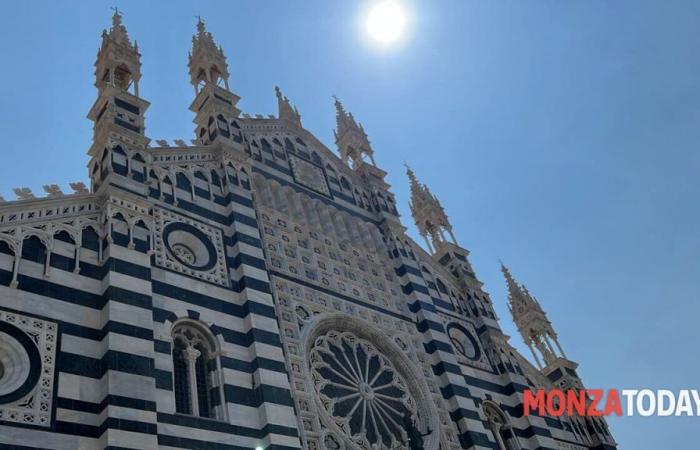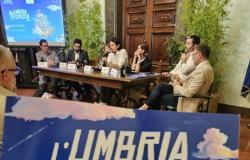For six centuries, in the cloister of the Cathedral of Monza, there has been a niche, covered by a wooden door still known to many, where inside and in a vertical position rests a mummy with a singular grin printed on its face. Which indeed, is particularly terrifying to look at.
For the record, this is a man who lived 600 years ago, a valiant leader whose history is intertwined with that of medieval Monza and whose memory the city pays homage to by preserving his body. Specifically, the mummy preserved in the Duomo is that of Estore Visconti, the only man who ancient Modeotia and its lands had as a lord and the one for whom Monza had, for the first and only time, its own coin.
The story of the valiant leader is told by the “lady” of Monza Ghi Meregalli, creator of the famous historical parade of Monza June and always involved in the study and dissemination of the events and traditions linked to the city of Teodolinda: “When I was little together I went to play with the other children in Piazza del Duomo. And I remember that that mummy in the cloister scared me greatly. Estore governed the village of Modoetia for more than five years, and in May 1412 he also made himself recognized as Duke of Milan – he explained – Unlike the other Viscontis, who were mostly seen as cruel and sinister characters ready for atrocious betrayals and revenge, Estore was very much loved and determined in Monza, he was in fact known for always maintaining a certain loyalty and relative respect for his people enemies He was one of the countless illegitimate children of Bernabò, fathered by Beltramola de’ Grassi, scion of the lords of Cantù. It was 8 August 1407 when the knight Ottobon Terzi and his men freed him from the terrible prison of the Forni of the castle of Monza. where the Rinascente palace was later built, ed.), where he was unjustly detained by order of the cruel duchy Giovanni Maria, son of Gian Galeazzo and duke of Milan, since 1405. From that moment began the victorious parable of what was defined as ‘ the magnificent, daring and fearless knight Estore, acclaimed by the Ghibelline faction as head of the city until 1415”.
Monza and its currency
“Among the best mercenary captains of his time, his exploits and those of his militias were known and feared throughout central and northern Italy (the conquest of the castle of Trezzo in 1385, in an attempt to recover the legacy usurped with the murder of his father at the hands of Gian Galeazzo, obtained with the unpredictable climbing of the high cliffs on the Adda) as well as his courage and ability to handle weapons” Meregalli further explained. “Thanks to him, and to the political autonomy he managed to obtain from the nearby and powerful Milan, Monza had a great boost in artisanal and mercantile activities. And the rebirth was such that Estore also decided to have money minted in Monza in a mint local It was the large Visconti, a silver coin which on the obverse bore the Visconti snake and the Gothic monogram of the lord of Monza, and on the obverse the effigy of Sant’Ambrogio, in short represented a true golden period for the city”.
The death of Estore
After the proclamation in Monza, the courageous leader had however wanted to aim higher, namely that Milan to whose lordship he felt legitimized. “He had tried in May 1408, but the lack of money to pay the troops had forced him to desist from the enterprise. He had succeeded in 1412, on the death of Giovanni Maria, remaining such until June of the same year. However, defeated by Filippo Maria, brother of Giovanni Maria, he had returned to take refuge in Monza together with his sister Valentina, where on August 8 he was besieged by the leader Carmagnola. Here, in the courtyard of the castle, while he was intent on watering his horse, a stone thrown by a catapult of the besiegers broke the instep of his left foot causing his death after three days”.
“Thus ended the brief adventure of Estore Visconti, even if the signature at the bottom of the story was placed by his courageous sister Valentina, who generously continued to defend the Monza fortress for more than two months. It was she who personally negotiated the surrender with the new commander ducal Carmagnola, obtaining the rehabilitation of his relatives and the celebration of Estore’s funeral at the duke’s expense with a great display of horses, flags and ‘servants dressed in brown’”.
The stockfish and the mummy in the Duomo
The Cathedral Museum today houses the Visconti sword, better known as stocco, from which the term stoccata was derived. “Its peculiarity lies in the double-edged blade, long and thin so as to be able to pierce iron armor. The hilt has a gold-engraved plaque in the center and the pommel is decorated with alternating Visconti coats of arms, in other words the cross and the snake. The braid that covers the hilt represents the chivalric order of the Braid, established by Albert of Austria between 1365 and 1395, to which Estore belonged.”
Estore’s body instead rests in the cloister, which once served as a cemetery. “After his death, his body had in fact been placed in a stone basin near the Lambro river before being buried in the subsoil of the Cathedral – concluded Meregalli – The total bleeding, and the muddy waters of the Lambro, probably contributed according to the more recent studies to the almost perfect mummification of the body”
A mummy that still reminds the people of Monza of the extraordinary story of the daring captain of fortune. It is worth discovering, by taking a quick look at the niche and challenging the fear of finding yourself in front of that face with a disturbing grin.






